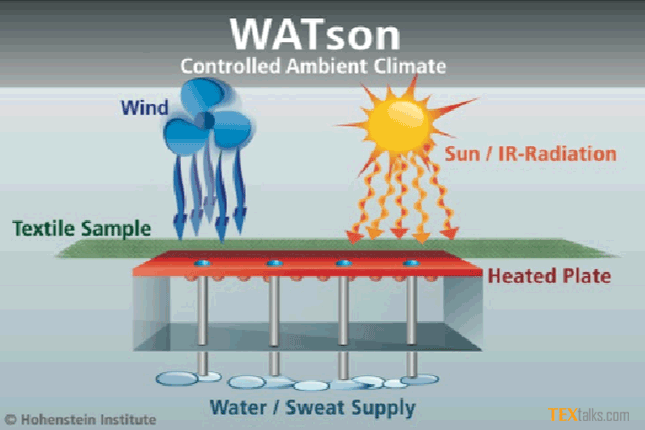Phase Change Materials (PCM) play an important role in modern textiles. The Hohenstein Institute has investigated how effective PCM products are with the help of the WATson Heat Loss Tester.
BÖNNIGHEIM (blb)Whether for sports or outdoor wear, personal protective clothing or for bed linen: PCM textiles are becoming increasingly popular. But the greater the number of applications, the greater the demands made on textiles containing PCM. How is the effect they promise perceived by the wearer of such textiles? Until now there has not been any clothing-related physiological method of measuring this. Physical measurements were only able to indicate changes in temperature.
A research project currently underway at the Hohenstein Institute has developed the first measuring method that allows the effect and efficacy of PCM in textiles to be tested without costly wearer trials. This new test method has not only made it more simple to demonstrate the functionality of textiles but also to offer proof of quality. This research project involved testing PCM-containing products from the market and coating textile samples with varying quantities of PCM.
Does PCM keep what it promises?
Visual inspection allowed differences in PCM modification of the various products to be identified. In the case of coatings, it was also possible to detect variations in terms of the quantity and mixing ratio of the substances applied. The encapsulation of PCM in fibres brings about changes in the physical properties of textiles, with some samples showing an improvement in tensile strength. Others, however, revealed adverse effects, due to poor mixing ratios, uneven spinning masses or porous PCM in the spinning mass.
Investigation of abrasion resistance showed that PCM fibres make twisted yarns rupture more easily in comparison with a reference yarn. Textiles coated with PCM demonstrated low resistance to rubbing and reprocessing. A huge deterioration in the quality and thickness of the coating is observed here. The wash resistance of the PCM finish tested is low, with the PCM material disappearing altogether from many samples after 10 washes.
The heat-insulating properties of PCM products vary widely and depend on the basic construction of the textile. Greater heat insulation was observed for material structures with the use of PCM technology. This is not solely due to the PCM, but first and foremost to the binder systems additionally employed. It was observed here that the heat insulating property of the tested materials was slightly better if the coated side faced the skin. Water vapour resistance is generally impaired by the addition of PCM and depends on the structure of the textile.
Wearer trials confirmed by WATson:
The effect of PCM textiles was demonstrated using the WATson Heat Loss Tester, which is capable of simulating heat build-up and sweating. It was possible to correlate the objective data measured in the investigations using the Heat Loss Tester with the results of wearer trials on PCM textiles. Tests performed on human subjects demonstrated the cooling effects of PCM textiles. In terms of skin temperature, they are extremely low. The measurements obtained with the WATson Heat Loss Tester were confirmed by the data from the wearer trials.

Heat Loss Tester measurement device to
measure the cooling power of textiles. ©
Hohenstein Group
WATson – a gain for the textiles industry:
These research results make it possible to manufacture new products with a high, verifiable level of functionality and allow them to be tested in terms of function. The WATson Heat Loss Tester supplies objectively measured data, which can now be correlated with results from wearer trials. Small and medium-sized enterprises in Germany’s textiles industry can in the future call on an objective measuring method for PCM textiles that allows them to supply proof of product quality.



